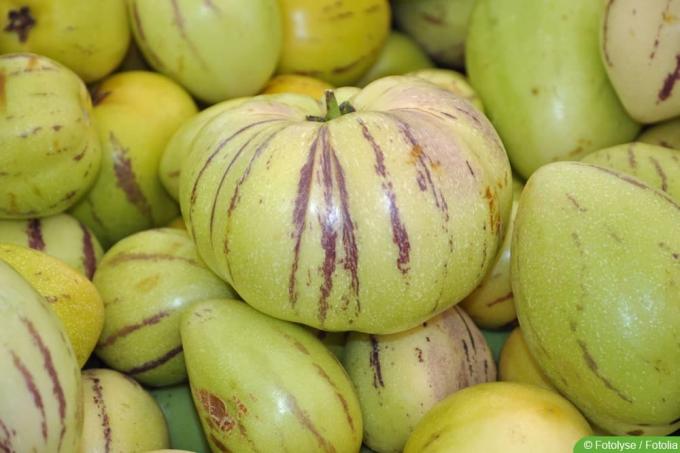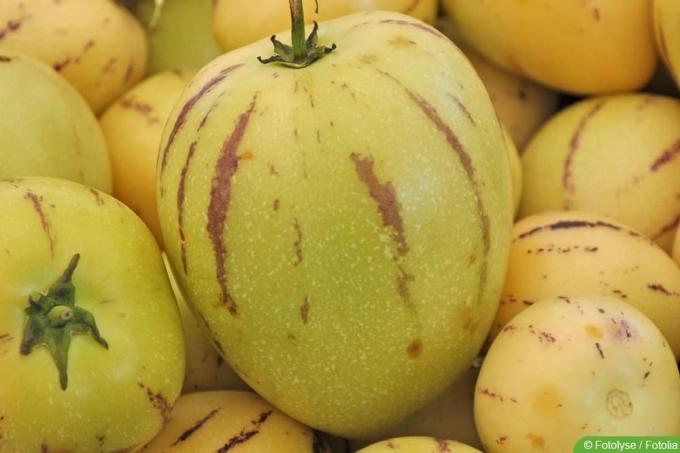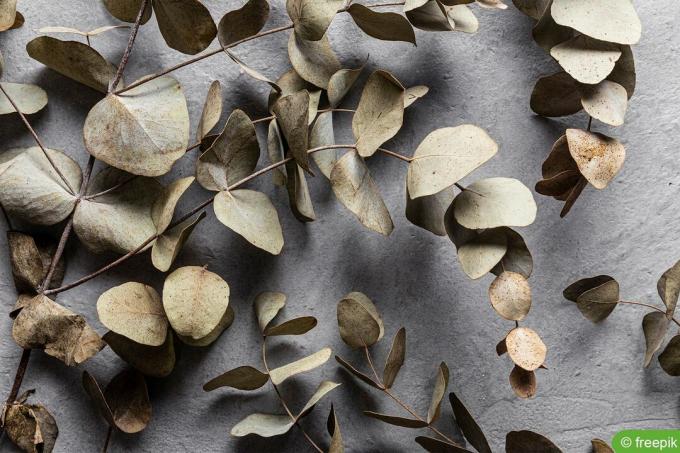

Table of contents
- Location
- outdoor
- substrate
- planter
- Pour
- Fertilize
- Cut
- multiply
- cuttings
- harvest
- repot
- hibernate
- Mistakes in care, diseases and parasites
- Appropriate Varieties
The melon pear, also known as pepino, belongs to the nightshade family. Originally from South America, it is now grown commercially in numerous countries and can also be an asset to the home garden. From growing to pruning, here is a complete A to Z care guide.
Location
The pear melon, which comes from South America, needs three main factors at the location:
- warmth
- light or sun
- Protection
The plant does not tolerate cold wind and frost. A protected location near a house wall or larger plants that can keep the wind out is therefore ideal. In addition, the melon pear should always be cultivated in a bucket. It is important that the wall or other plants do not cast too much shadow on the nightshade plant. A conservatory can also be a suitable location. However, attention must be paid to adequate ventilation and the possibility of fertilization if the plants are to bear fruit.
Tip:
The plant can certainly be planted outdoors, but is then only an annual or must be dug up and wintered indoors before the onset of the first frost in autumn.
outdoor
Due to their sensitivity to frost, the melon pears may only be brought outdoors when frost or late frost is no longer to be expected. In most regions this is only after the Ice Saints.
A notice:
On a plant trolley or a furniture trolley, the plants can be taken outside during the day and put back inside at night to protect them from frost. This makes sense, especially with older and larger plants, and makes work easier.
substrate
The pear melon needs a loose and humus-rich substrate. Potting soil mixed with coconut fibers and adding well-rotted compost are well suited, for example. It can also be useful to add sand to prevent compaction of the substrate and make it more permeable.
In any case, it is important that drainage is also installed in the planter, because the melon pear does not tolerate waterlogging. Suitable materials for the drainage layer at the bottom of the pot or bucket are ceramic or pottery shards, coarse gravel and stones.
planter
The planter should be chosen in size and quality so that it offers stability and stability but is not too big. Because a large pot or tub promotes root growth, but does not stimulate fruit formation. It also makes sense to repot every year, in which the planter is only slightly larger than the previous one.
Pour

The pear melon needs a lot of water, but as mentioned, it does not tolerate waterlogging. It can and should therefore be watered regularly and well, but always in moderation. The so-called thumb test is ideal. A thumb or other finger is pressed lightly into the surface of the substrate. If the soil feels damp or even sticks to your finger, it does not need to be watered again. However, if the top layer is dry and crumbly, the plant should be watered. The best way is to use low-lime, soft water. This means that the following sources are suitable:
- collected rainwater
- stagnant or soft tap water
- pond or aquarium water
With water from the garden pond or aquarium, however, care must be taken to ensure that it does not contain any potentially harmful additives.
Fertilize
If you use water from a pond or aquarium for watering, you can hold back on other fertilizers. Because food leftovers, parts of plants and excrement of aquatic creatures contain plenty of nutrients in the water. Alternative fertilizers for the pear melon are:
- Complete fertilizer for fruit and vegetable plants
- well rotted compost
- low-nitrogen fertilizer
- Plant manure, for example from nettles
During the growth phase - i.e. from around the end of May to the beginning of September - the plant can be fertilized every two weeks. After repotting or a change of soil, additional fertilizers can be dispensed with for one to two months. The prerequisite for this is, of course, that a nutrient-rich soil or the addition of compost is chosen.
Cut
Pruning the melon pear serves two purposes. On the one hand, the removal of shoots without flowers, the so-called pinching, can direct the power of the plant into the development of further flowers and shoots. Shortening all other shoots can limit the size of the plant and encourage larger fruit as well.
In and of itself, however, a blend is not absolutely necessary. Nonetheless, it makes sense. Controlling size and girth and directing effort are two key reasons to do this. Another factor that speaks in favor of the blend is to keep the pepino plant healthy. Removing damaged or dead shoots reduces the risk of disease and parasite infestations. However, there are a few factors that should be taken into account. These points are:
- use clean cutting tools, preferably the blades should be disinfected
- choose dry weather for cutting
- in the case of larger cuts, apply charcoal ash to the cut surfaces in order to achieve a quick seal and rapid drying
multiply
There are two ways to propagate the pear melon. On the one hand, multiplying by seeds from the fruits. On the other hand, propagation via cuttings. Propagation from seeds requires a little more patience, but is otherwise quite easy. Propagation via cuttings is more complex, but takes less time.
- For propagation via seeds, the seeds can be obtained directly from the fruit or purchased from specialist retailers.
- The seeds are placed in potting soil and only lightly covered with substrate.
- The planters are placed in a warm and bright place and the soil is kept moist. Temperatures around 20 °C are ideal. After two to three weeks, the first germs should appear.
- When the plants have reached a height of about ten centimetres, they can be moved to the more nutrient-rich substrate described above.
cuttings
If propagation via cuttings is chosen, the procedure is as follows:
- Shoots about ten centimeters long are cut off the mother plant. For this, it is imperative to use a knife or scissors with clean and very sharp blades.
- The shoots are placed about four centimeters deep in a suitable substrate. Sand or potting soil, for example, are suitable.
- The substrate is well moistened, but should not be waterlogged. As an alternative to the moist substrate, the cuttings can also be placed directly in water.
- The substrate is checked daily and watered if necessary. If the substrate has been dispensed with, it should be changed every two to three days. Otherwise the water could turn into liquid manure and the reproduction would not work.
- The planter or glass is again placed in a bright and warm place.
- After about three weeks, enough roots should have formed that the young cuttings can be planted in the ground.
harvest
When the fruits of Solanum muricatum can be harvested depends on the variety. The popular Sugar gold bears ripe fruit from around late summer, which can be eaten with the peel. The harvest time extends into autumn. The last fruits should be harvested in the winter quarters so that the plant is not damaged by frost.

In addition to the variety, the weather and preparation are also important. A Pepino grown indoors, which receives a lot of light and warmth in summer and is sheltered, provided with sufficient water and fertilizer, can bear ripe fruit earlier in summer. It is also beneficial if care includes cutting the shoots without buds or flowers, so that more power is available for the development of the fruit. Each fruit can be removed or cut off by hand. Ripeness can be recognized by the fact that the melon pears give off a fruity smell and give slightly when pressed.
repot
The melon pear should be repotted once a year to provide fresh substrate and, if necessary, more space. An ideal time for the measure of care is the transition from the winter quarters to the open air. However, special features do not have to be taken into account. The pear melon is treated simply as follows:
- The crop is removed from the pot and from the soil.
- The old substrate should be removed as much as possible. You can either use a brush or rinse off the soil.
- If necessary, damaged or dead roots can be removed.
- If necessary, a new, larger pot can be used. In any case, new substrate should be used. In addition, the drainage in the bucket should not be forgotten.
In the first period after repotting, additional fertilization can be dispensed with, as the fresh substrate provides sufficient nutrients.
hibernate
Overwintering the melon pear is very easy, all you need is a suitable room. Before the first frost in autumn, the crop is brought indoors. It should be in a room that is between five and ten degrees. In addition, the room should be as bright as possible. A bright basement or the stairwell can be suitable.
If you do not have such premises yourself, you can let the plant overwinter in a nursery. The fertilization is stopped and only so much is poured that the substrate does not dry out. The amount of water is not increased again until spring.
Tip:
If there are still fruits on the plant in autumn, they will continue to ripen during the winter. So they can be harvested when they are ripe and remain on the plant for as long as they are.
Mistakes in care, diseases and parasites
As a nightshade plant, the pear melon can harbor the same diseases and pests as tomatoes and potatoes. In addition, care errors can also cause problems for the plants. Some of the harmful and debilitating influences include:
- Fertilizers with too high a nitrogen content drive leaf growth, but can have a negative effect on fruit formation
- Colorado potato beetles eating the leaves
- Potato powdery mildew, which can lead to a general weakening of the plant and is manifested by coatings on the leaves and shoots
- Lice, which can cause discolored patches
- Snails that eat the shoots and leaves, especially on young plants
- Waterlogging that can lead to rot
- Tomato bronze spot virus which can cause plant death
A review of culture conditions and care should be the first step in any damage. In the case of pests, home remedies can already be sufficient to combat them. In the case of diseases, home remedies or special products from the trade can be used.
Appropriate Varieties
A particularly suitable variety of melon pear is the already mentioned Sugar gold. The plants are about one meter high, are self-fertile and even the skin of the fruit can be eaten. With optimal conditions of care and a suitable location, it can bear fruit from summer to autumn.
 garden editorial
garden editorial I write about everything that interests me in my garden.
Learn more about tropical plants

Eucalyptus dry leaves: what to do?
Actually, the decorative eucalyptus seems quite healthy and there are no pests to be seen. Nevertheless, the tree suddenly gets dry leaves. Usually it is care mistakes that cause the leaves of the eucalyptus to suddenly dry up. However, rapid intervention can ensure the tree's recovery.

Cutting passionflower: Instructions | Cut back from overwintering
The passion flower (Passiflora) comes from South America and accordingly has special care requirements in central European regions. Above all, you should find out more about cutting and winter preparation in the plant guide so that your specimens can develop magnificently.

Alocasia, Elephant Ear - Yellow Leaves Care and Help
The approximately 70 species of Alocasia, also known as elephant ear, taro, arrowhead or tropical root, are among the exotic indoor plants that are not exactly easy to care for. They impress above all with their sometimes huge leaves with different leaf shapes and unusual leaf markings.

Bat flower, Tacca chantrieri - cultivation and care
Extraordinary, exotic and extremely decorative: Whoever sees the bat flower for the first time is guaranteed to look twice. The imposing plant with the brown-violet flowers and the long whiskers surprises and delights every garden visitor. The question quickly arises: what is the best way to successfully cultivate this impressive plant?

Planting tobacco seeds - varieties and cultivation
Tobacco cultivation has a centuries-old tradition in Europe and is more relevant today than ever in hobby gardens. Growing tobacco seeds is fun and results in an unprecedented pleasure, without harmful additives, while ornamental tobacco attracts everyone's attention. Here you will find recommended varieties and instructions for cultivation.

Sugar cane plant - profile and cultivation in the garden
Growing the world's most important plant for sugar production in your own garden is an exciting experience. At the same time, the sugar cane plant is extremely decorative and easy to care for. The following profile conveys all the impressive attributes. This is how cultivation in the garden succeeds.


